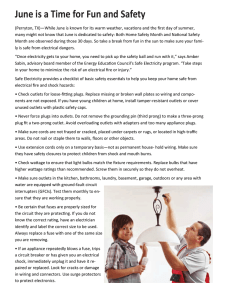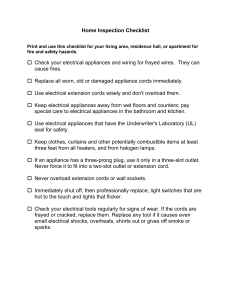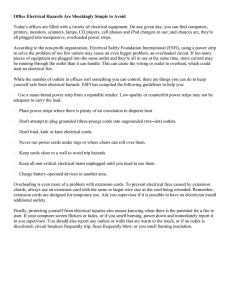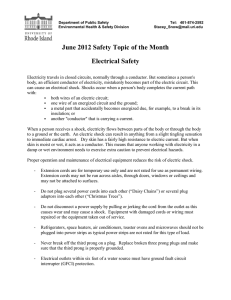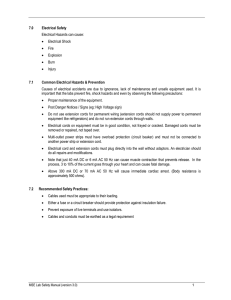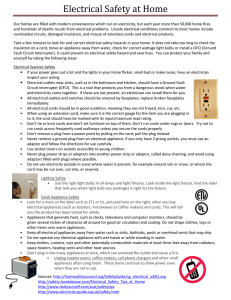Electrical Safety for Household Consumers
advertisement
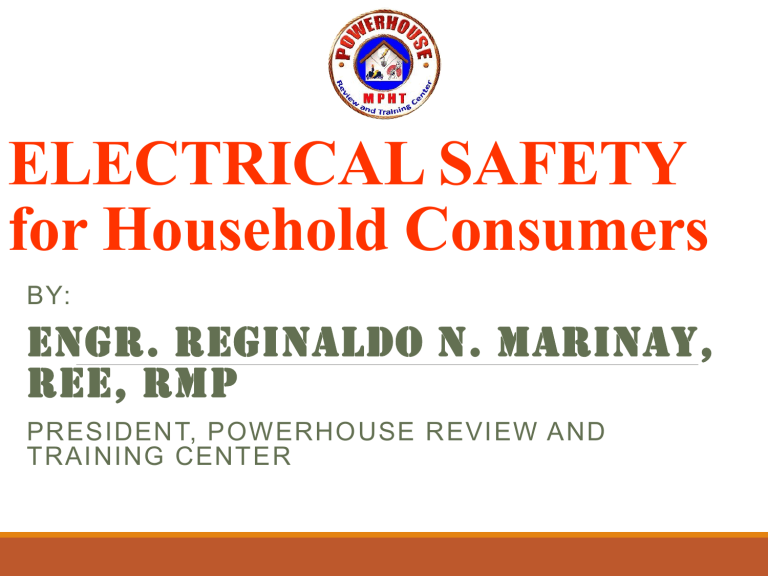
ELECTRICAL SAFETY for Household Consumers BY: ENGR. REGINALDO N. MARINAY, REE, RMP PRESIDENT, POWERHOUSE REVIEW AND TRAINING CENTER Effects of Electricity on Human Body Why Worry About Electricity? Electrocutions rank fourth in causes of industrial fatalities (behind traffic, violence and construction). It is estimated that 600 people die every year of electrical causes. Most of these accidents involve low voltage (600 volts or less). 2 Graphs Electricity flowing through the human body can shock, cause involuntary muscle reaction, paralyze muscles, burn tissues and organs or kill. In case of electric shock, the amount of current flow through the body and the corresponding body sensation are identified in the following graph. 3 4 Graph: Electric Shock Vs. Body Sensation A small night-light with a 6-watt bulb draws 0.05 ampere, and even that small amount of current can be fatal. Here are some effects of current (in milli amps) passing through a 150 pound body (note that perception is only 0.5 to 1.5 milli amps). 5 6 Current passing through your body can cause electric shock, resulting in 3 types of potential injuries: Burns (arcs burn with heat and radiation) Physical injuries (broken bones, falls and muscle damage) – at 10 milli amps, the muscles clamp on to whatever the person is holding. Nervous System Effects (stop breathing at 30 to 75 milli amps AC at 60 Hz, fibrillation at 75 to 100 milli amps at 60 Hz) 7 Fibrillation – a muscular twitching involving individual muscle fibers acting without coordination. - very rapid irregular contractions of the muscle fibers of the heart resulting in a lack of synchronism between heartbeat and pulse. - heart is “twitching” and there is no blood flow to the body. The heart can be damaged because it is in the path of the most common routes electricity will take through the body: Hand to hand Hand to foot 8 Burns Although a current may not pass through vital organs or nerve centers, internal electrical burns can still occur. These burns, which are a result of heat generated by current flowing in tissues, can be either at the skin surface or in deeper layers (muscles, bones, etc.) or both. Typically, tissues damaged from this type of electrical burn heal slowly. 9 The critical path of electricity through the body is through the chest cavity. At noted levels, current flowing from one hand to the other, from a hand to the opposite foot, or from the head to either foot will pass through the chest cavity paralyzing the respiratory or heart muscles, initiating ventricular fibrillation, and/or burning vital organs. The effects of electric current on the human body can vary depending on the following: • Source characteristics – current, frequency and voltage of all electric energy sources. • Body impedance and the current’s pathway through the body. • How environmental conditions affect the body’s contact resistance. • Duration of the contact 10 Static Electricity and How It Can Do Harm? Why minimize static shocks? •You may be injured by the reaction to the shock even though the shocks are not hazardous! 11 What you can do? 1) Never clean the glass face of your computer monitor while the computer is on. 2) During normal operation, the glass surface of a monitor’s CRT accumulates an electrostatic charge. When you touch the screen with a finger, the charge in the portion of the screen you touched discharges through your finger with a tiny spark. Electric current does not normally flow through glass so only part of the screen that your finger touches is discharged. When you clean a monitor however, the entire glass is wet and the charge on the entire screen will discharge to your finger or hand, causing a much more painful shock. Clean your monitor before you turn on your computer. 12 What you can do? 3) Never allow any electrical powered office equipment to become wet while it is turned on. 4) Never turn on any electronic equipment when it is wet. 5) Even when a computer has been turned off for a few minutes, it is best not to touch the monitor’s CRT while handling or using other electrical / electronic equipment, including the telephone. Wet or dry, you may receive an electric shock. This shock is similar to the shock you receive when you touch a door knob after walking across a carpet. Although painful, this type of shock is not hazardous. However, you may be injured by the reaction to the shock, such as pulling your hand rapidly away and hitting your elbow against a wall or cabinet. 13 Controlling Electrical Fire Stages of Fire. •There are four (4) stages of fire: 1. Incipient stage – no visible smoke or flame 2. Smoldering stage – there is no smoke but no flame 3. Flame stage – actual fire exist and heat builds up 4. Heat stage – uncontrollable spread of superheated fire An electrical fire originates from an energized electrical equipment, wiring, fuses and appliances. Its extinguishment calls for a non-conductive dry powder, carbon 14 dioxide or vaporizing liquid. Never use water to avoid shock at fatal electrocution. Electrical Fire Prevention Practices Keep hallways and stairways clear for quick exits and always equip them with smoke detectors whenever possible. Properly placed detectors cut your chances of dying in a home fire. Put them on every level of your house and outside each bedroom. Check the test button weekly and clean it regularly. Make sure everybody knows the sound of alarm. 15 Electrical Fire Prevention Practices Blown fuses, warm outlet plates, sparks from switches and outlets – all could be signs of an overloaded electrical system or faulty wiring. The Bureau of Fire Protection (BFP) identifies “octopus connections” – where several electrical appliances are connected to 1 outlet, resulting in power overload and other electrical faults – as the main cause of fires in the home. Avoid having such connections in your house. 16 Electrical Fire Prevention Practices Never leave hot appliances plugged-in when you are not around. If you have big appliances such as a window air conditioner, plug them into their own heavy duty electrical circuit, not just an outlet. Let air circulate around your TV set and at the back of your refrigerator to dissipate build-up heat. Don’t place watered plants on top of the set or ref. 17 Electrical Fire Prevention Practices Use extension cords only within their designated rating. Never let multi-outlet assemblies or cube taps cause overloads. Never use frayed or deteriorated extension cords. Never tamper with fuses to change their current carrying capacity. 18 Causes of Electrical Accidents Unsafe Acts •There are 3 major causes of electrical accidents: 1) Carelessness 2) Misuse 3) Getting in a hurry 19 There are 2 reasons for the above causes of unsafe acts: 1. We know better but intentionally do something unsafe. 2. We don’t know better. 20 Avoid the following unsafe acts: •Failure to de-energize, lockout and tag-out hazards during maintenance, repair or inspections of fuse box. •Use of defective and unsafe tools. •Use of tools or equipment too close to energized parts. 21 Avoid the following unsafe acts: •Not draining off stored energy in capacitors. •Using 3 wire cord with a 2 wire plug. •Remove and replace wrong fuse. •Not verifying power is off when making repair (drilling into a 220 V AC line can kill). 22 Unsafe Equipment What equipment can cause electrical accidents? •Loose connections •Faulty insulation •Improper grounding •Defective parts, such as broken outlet cover (unsafe accessible LIVE contacts) 23 Common Electrical Violations Causing Dangers The most apparent requirements in determining unsafe equipment are related to the existence of the power supply; the types, locations and conditions of the wiring in use; and the existence of the number of wall outlets or ceiling fixtures required by the PEC and their condition. In making investigations of unsafe equipment, these considerations will serve as useful guides. 24 1) Power Supply – where is it located, is it grounded properly, and is it at least of minimum capacity required to supply current safely for lighting and the major and minor appliances in the dwelling? 2) Panel Box Covers or Doors – these should be accessible only from the front and should be sealed in such a way that they can be operated safely without the danger of contact with live or exposed parts of the wiring system. 25 3) Switches, Outlets and Junction Boxes – these also must be covered to protect against danger of electric shock. 4) Frayed or Bare Wires – these are usually the result of long use and drying out and cracking of the insulation, which leave the wires exposed, or else a result of constant friction and rough handling of the wire, which cause it to fray or become bare. Wiring in this condition constitutes a safety hazard, and correction of such defects should be ordered immediately. 26 5) Electric Cords Under Rugs or Other Floor Coverings – putting electric cords in locations such as these is prohibited because of the potential fire hazard caused by continuing contact over a period of time between these heat-bearing cords and the flammable floor coverings. Direct the occupant to shift the cords to a safe location, explain why, and make sure it is done. 6) Bathroom Lighting – it should include at least 1 permanently installed ceiling or wall light fixture with a wall switch and plate so located and maintained that there is no danger of short circuiting from use of other bathroom facilities or splashing of water. Fixture or cover plates should be insulated or grounded. 27 7) Lighting of Public Hallways, Stairways, Landings and Foyers – a common standard here is sufficient lighting to provide illumination of 10 ft-candle on every part of these areas at all times. Sufficient lighting means that a person can clearly see his feet on all parts of the stairways and halls. Every public hall and stairway in a structure containing less than 3 dwelling units may be supplied with conveniently located light switches controlling an adequate lighting system that may be turned on when needed instead of full-time lighting. 28 8) Habitable Room Lighting – the standard here may be 2 floor convenience outlets – although floor outlets are dangerous unless protected by proper dust and water covers – or 1 convenience outlet and 1 wall or ceiling electric light fixture. This number constitutes an absolute and often inadequate minimum given the contemporary widespread use of electricity in the home. The minimum should be that number is required to provide adequate lighting and power to accommodate lighting and appliances normally used in each room. 9) Octopus Outlets or Wiring – this term is applied to outlets in which plugs have been inserted and are being used to permit more than 2 lights or portable appliances, such as TV, lamp or radio, to be connected to the electrical system. The condition occurs where the number of outlets is insufficient to accommodate the normal use of the room. This practice overloads the circuit and is a potential source of fire. 29 10)Outlet Covers – every outlet and receptacle must be covered by a protective plate to prevent contact of its wiring or terminals with the body, combustible object or splashing water. 11)Excessive or Faulty Fusing – the wire’s capacity must not be exceeded by the fuse or circuit breaker capacity or be left unprotected by faulty fusing or circuit breaker. Fuses and breakers are safety devices designed to “blow” as a means of protection against overloading of the electrical system or 1 or more of its circuits. 30 12) Cords Run Through Walls or Doorways and Hanging Cords or Wires – this is a makeshift-type installation and most often is installed by an unqualified handyman or do-ityourself occupant. 13) Temporary Wiring – this type of installation should not be allowed, with the exception of extension cords that go directly from portable lights and electric fixtures to convenience outlets. 14) Excessively Long Extension Cords – this requirement does not apply to specially designed extension cords for operating portable tools and trouble lights. Cities operating under modern code standards limit the length of loose cords or extension lines to a maximum of 8 feet. This is necessary because those that are too long will overheat if overloaded or if a short circuit develops and thus create a fire hazard. Even shorter lengths are feasible in housing with new or updated wiring system that include 1 convenience outlet every 12 feet around the perimeter of the room. 31 Hazardous Environment Use special precautions when working in potentially hazardous environments and situations. Even an accidental static discharge can cause a fire or explosion in areas where the following are present: Flammable vapors, liquids and gases Combustible dust Corrosive atmospheres Explosive environments 32 Safety Practices All violations of the Philippine Electrical Code (PEC) represent potentially dangerous arrangements. In order to correct these situations, the following safety practices are encouraged. 33 Basic Safety Practices: •Never underestimate the danger of 220 VAC circuits. More people die from 220 VAC electrical shock than any other voltage. This is mostly due to a lack of respect. •Watch out for electrical arcs; they can cause bad burns. •Do not operate equipment beyond its rated capacity. •Never install equipment beyond its rated capacity. 34 Don’t Play With Electrical Equipment: •Don’t stick any object other than an electric plug into an outlet. •Never fool with wires, electric meters , switches or any electrical equipment in and around the house and yard. •Don’t break insulators or electrical equipment •Stay away from transformers (green boxes) and power substations. Use Appliances Safely: • Never use any electrical appliance when you’re wet, have wet hands, or when you’re standing in water. • Keep all electric appliances at least 10 feet away from swimming pools. Caution: Remember, electricity is your friend, but use it safely. 35 Safety Checklist Outlets •Check for outlets that have loose-fitting plugs, which can overheat and lead to fire. •Replace any missing or broken wall plates. •Make sure there are safety covers on all unused outlets that are accessible to children. 36 Cords •Make sure cords are in good condition – not frayed or cracked. •Cords should never be nailed or stapled to the wall, baseboard or to another object. •Do not place cords under carpets or rugs or rest any furniture on them. •See that the cords are not overloaded; and they are not meant to be used permanently as household wiring. 37 Plugs •Make sure plugs fit your outlets. •Never force a plug into an outlet if it doesn’t fit. •Avoid overloading appliances. outlets with too many Light Bulbs • Check the wattage of all bulbs in light fixtures to make sure they are the correct wattage for the size of the fixture. • Replace bulbs that have higher wattage than recommended. • Make sure bulbs are secured in securely; loose ones may overheat. 38 Circuit Breakers / Fuses •Should be the correct size current rating for their circuit. •If you do not know the right size, have a registered master electrician (RME) identify and label the size to be used. •Always replace a fuse with the same size fuse rating. Water and Electricity Don’t Mix • Don’t leave plugged-in appliances where they might come into contact with water. • If a plugged-in appliance falls into water, never reach in to pull it out… even if it is turned off. First turn off the power source at the panelboard and then unplug the appliance. Appliance • If an appliance repeatedly blows a fuse, trips a circuit breaker, or if it has given you a shock, unplug it and have it repaired. 39 Outdoor Safety •Electric powered tools and equipment should not be use in the rain or wet conditions. •Always use an extension cord marked for outdoor use and rated for the power needs of your tools. •Remember to unplug all portable tools when not in use. •Since metal ladder conducts electricity, watch out for overhead and power lines. 40 Lightning • During a storm, do not use appliances (i.e. hairdryers, toasters, radios) or telephones (except in an emergency). • Do not take a bath or shower during a storm. • Keep batteries on hand for flashlights in case of a power outage. 41 Following are the safety precautions to take with switches and receptacles: 1. All switches and outlets should be checked periodically to make sure they are not hot to the touch. If switches and outlets don’t work properly, hot to the touch, produce sparks or arcs when used, or if the switch or outlet blows a fuse or trips a circuit breaker, this could indicate an unsafe wiring condition. Have a licensed electrician check the switch or outlet. 2. All outlets should have a faceplate to help prevent exposure to “live” wiring. 42 Following are the safety precautions to take with switches and receptacles: 3. If plugs seem to fit loosely in an outlet, the same may be worn and could overheat; a licensed electrician should check it. 4. Put inexpensive safety covers on receptacles to help prevent children from inserting small objects into it. 5. All outside receptacles, as well as in bathroom, kitchen and basement should be weatherproof or have waterproof covers to help protect against shock hazards. 43 Do’s & Don'ts for Electrical Safety 1. Do use extension cords on a temporary basis. 2. Do put safety covers on unused receptacle outlets and extension cords. 3. Do unplug an appliance and call an electrician if the receptacle face-plate feels hot or if there is sparking, smoke, color or odor coming from the outlet, plug or appliance. 44 Do’s & Don'ts for Electrical Safety 4. Do examine appliance and extension cords regularly for signs of wear or tear or damage to insulation. 5. Do unplug all non-essential electrical appliance when not in use. 6. Do use extension cords that have been listed by a nationally recognized testing laboratory. 7. Don’t use extension cords as permanent substitute for inadequate house wiring. 45 Do’s & Don'ts for Electrical Safety 8. Don’t use extension cords that are worn or damaged and don’t attach extension cords to the wall with nails or staples. 9. Don’t put extension cords under rugs where they might be walked on; don’t rest anything on an extension cord. 10.Don’t overload cords with too many appliances. 11.Don’t touch any appliance that has emitted an electrical shock until the appliance has been unplugged. 46 Do’s & Don'ts for Electrical Safety 12. Don’t place electrical appliances where they might come in contact with water. Never reach into water for plugged-in appliance… turn off power first, then unplug it. 13.Don’t place an appliance cord where it might touch a hot surface. 14.Don’t leave any wiring exposed in outlets and switches. Use the correct size faceplate. 15.Don’t ignore switches or outlets that don’t work. Obtain the help of a licensed electrician. 16.Don’t let cords hang over countertops where children can pull down an appliance. 47 Hazards and Safety Tips for Electricians The Philippine Electrical Code (PEC) sets the minimum standards for electrical work in general and specific instances. Any person employed in the electrical field should obtain a copy of the PEC and know how to use it. This is commonly referred to as the electrician’s handbook. 48 Basic Safety Precautions Never bypass a fuse. Be sure all current carrying electric lines are well insulated. Always check a circuit for voltage before servicing. Know where all emergency shutdown switches are located. Work on live circuits only when absolutely necessary. Watch for burned wires on electrical devices. Never touch a conductor without first testing. Look for loose conductors in electrical systems. Do not make any adjustment or repairs to any electrical equipment until all power has been disconnected or the circuit breaker has been turned off. 49 Caution: Adjustments or repairs should be done only by licensed electrical engineers or electricians. •All electrical equipment and tools should be properly grounded to pre4vent any injury to the operator. •Do not operate electrical parts with wet gloves or wet clothing. Caution: To prevent harmful body shocks, keep hands, feet and clothing dry. Use a dry board or rubber mat when water, moisture or perspiration cannot be avoided. •Never work alone when working with more than 50 volts. 50 Safety Practices Around Live Circuits. •Use a reliable circuit tester or voltmeter to identify live circuits. •Stand on dry surface. •Use only one hand of possible. •Never keep tools lying around live conductors. •Wear suitable insulated hand covering. •Return all tools to pouch when through with them. 51 Proper Grounding. •Properly grounded electrical equipment provides a pathway to ground for stray current that may otherwise go through the operator’s body. •Loose wires that touch the case of housing in electrical equipment can cause an electrical shock to anyone who touches the equipment if it has not been properly grounded. Caution: A faulty current to the housing will travel directly to ground. A working touching the equipment is not likely to suffer a serious shock because the ground is a better current path than the human body. 52 Importance of Third Wire Always check for grounding or third wire before using electrical equipment to avoid electrical shock. The importance of third wire as follows: •Installed for personal protection. •Provides alternate path for current in case of a short. •Can save your life. 53 Ground Fault Circuit Interrupters (GFCI) When the ground fault circuit interrupter works properly, the power is cut off so fast that the shock can be reduced to a few microseconds. GFCI’s are: • Personal safety devices. • Required on 15 and 20 ampere receptacle outlets used for temporary power supply on construction sites. • Stops current before severe personal injury occurs. 54 Facts About Electric Shock Body Resistance Human body resistance varies from about 500,000 ohms when dry to about 300 ohm when wet. Because of this, voltage as low as 30 V can cause enough current to be fatal. Any circuit with a potential of at least 30 V must be considered dangerous. 55 Selecting an Electrical Contractor Right contractor for the job •If you’re trying to get your home/school/office/workplace’s electrical system inspected or upgraded w/out getting overcharged and ensuring electrical safe installation, you may be interested in these tips on how to select a qualified electrical contractor. 56 1) Check the phone book, usually under “Electric” or “Contractor”, or you may call the PCAB. Better yet, call the SPECS. 57 2. Ask where the contractor is located. There are some outof-area contractors that use the phonebook to solicit business. Ask for PRC licenses (PEE/REE/RME) and PCAB licenses (Specially Electrical Contractor). Ask for company profile. Phone the company to make sure the licenses are current. 3. Have more than one electrical contractor give you an estimate. Beware of non-licensed electrical practitioners. Most reputable companies require PRC and PCAB licenses before they can practice. 4. Ask for local references. You can alos call the IIEE Chapter in your area. Determine if the contractor is a member of a national or regional electrical association. Membership does not guarantee quality, but ongoing educational programs keep members up to date on the latest technological developments in the electrical industry. 12/9/2015 58 Electrical Accidents 12/9/2015 59 Electrical Accidents 12/9/2015 60 Electrical Violations 12/9/2015 61 Electrical Violations 12/9/2015 62 Electrical Violations 12/9/2015 63 END OF PRESENTATION 12/9/2015 64
